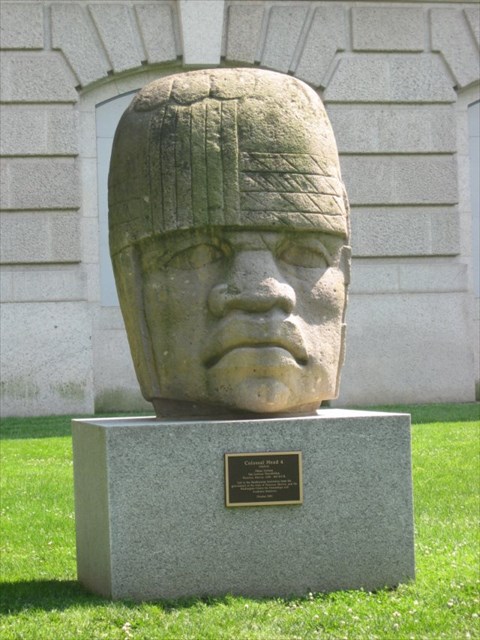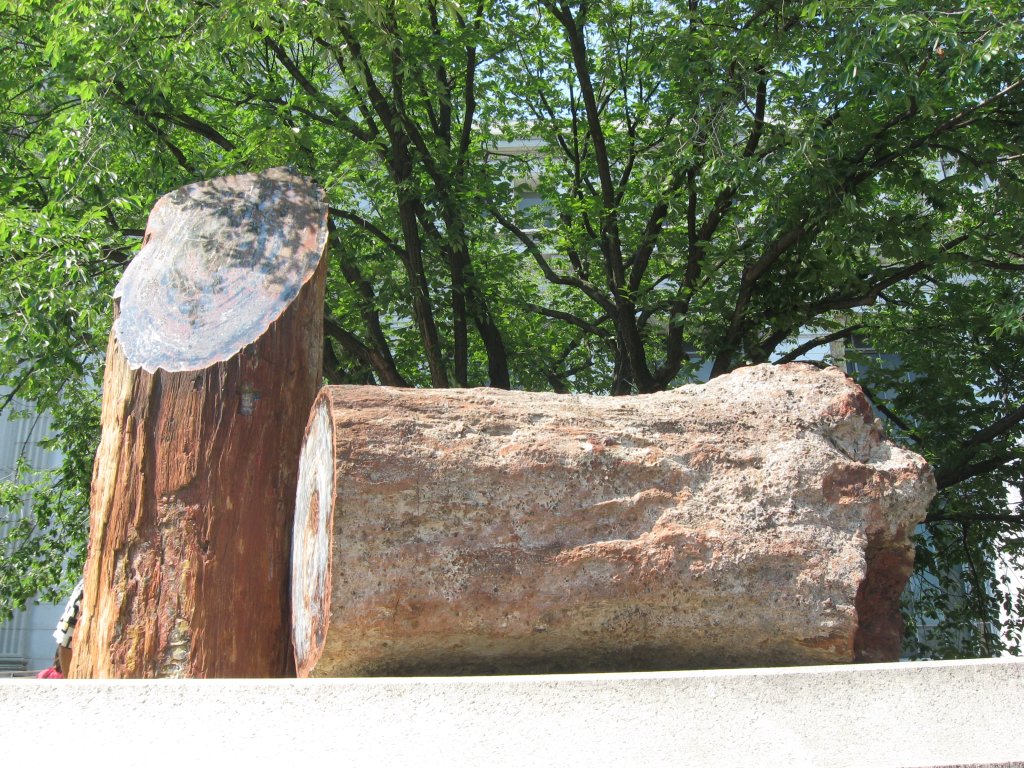A head and a piece of wood
This earthcache brings you to two geological spots around the Smithsonian Institution’s National Museum of Natural History.
The first spot is located at N 38° 53.510 W 077° 01.582. There you can see a Colossal Head from an ancient culture.

Click for enlargement
From a geological viewpoint the Colossal Head is made of basalt which is a common extrusive volcanic rock (the word "Basalt" is derived from Late Latin basaltes, misspelling of L. basanites "very hard stone). Normally it is grey to black and fine-grained due to rapid cooling of lava at the surface of a planet. In contrast unweathered basalt is grey or black. It may be porphyritic containing larger crystals in a fine matrix, or vesicular, or frothy scoria.
On Earth, most basalt magmas have formed by decompression melting of the mantle. Basalt can also be found on Earth's Moon, Mars, Venus, and even on the asteroid Vesta. The term basalt is at times applied to shallow intrusive rocks with a composition typical of basalt, but rocks of this composition with a coarse groundmass are generally referred to as dolerite or gabbro.
Due to the widespread occurrence of basalt masses, sizeable pieces of which have an overall homogeneity of color and other desirable characteristics, led to the early use of basalt for fashioning artifacts by the Olmecs, which have been found in South America. Among the basalt artifacts found are weapons, tools, and diverse sculpted and carved pieces, spearheads, adzes and scrapers, columns, bas reliefs, statues, statuettes, and manos and metates.

Click for enlargement
Petrified wood (from the Greek root petro meaning "rock" or "stone"; literally "wood turned into stone") is the name given to a special type of fossilized remains of terrestrial vegetation. It is the result of a tree or tree-like plants having completely transitioned to stone by the process of permineralization. All the organic materials have been replaced with minerals (mostly a silicate, such as quartz), while retaining the original structure of the stem tissue. Unlike other types of fossils which are typically impressions or compressions, petrified wood is a three-dimensional representation of the original organic material. The petrifaction process occurs underground, when wood becomes buried under sediment and is initially preserved due to a lack of oxygen which inhibits aerobic decomposition. Mineral-laden water flowing through the sediment deposits minerals in the plant's cells; as the plant's lignin and cellulose decay, a stone mould forms in its place.
In general, stem tissue takes less than 100 years to petrify. The organic matter needs to become petrified before it decomposes completely. A forest where the such material has petrified becomes known as a Petrified Forest.
Elements such as manganese, iron and copper in the water/mud during the petrifaction process give petrified wood a variety of color ranges. Pure quartz crystals are colorless, but when contaminants are added to the process the crystals take on a yellow, red, or other tint.
Following is a list of contaminating elements and related color hues:
carbon - black
cobalt - green/blue
chromium - green/blue
copper - green/blue
iron oxides - red, brown, and yellow
manganese - pink/orange
manganese oxides - blackish/yellow
Petrified wood can preserve the original structure of the stem in all its detail, down to the microscopic level. Structures such as tree rings and the various tissues are often observed features.
To log this earthcache, perform the following tasks (you do not need to wait for a log permission. I will contact and help you in the case one of your answers is wrong.):
- Which indicators can you identify that show you that the head is made of basalt?
- Have a close look at the petrified wood. Which of the elements mentioned in the earthcache description can you identify?
- How old is the petrified wood which you can see at the second spot?
- Optional: take a photo of you or your GPS at one of the two spots.
Sources: Wikipedia; Website about colossal heads
